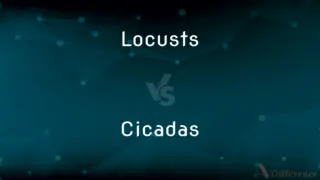Carbon Dots vs. Quantum Dots — What's the Difference?
By Tayyaba Rehman — Published on November 2, 2023
Carbon Dots are fluorescent nanoparticles derived from carbon, displaying biocompatibility, while Quantum Dots, semiconductor nanoparticles, exhibit size-tunable electronic properties and are widely utilized in electronics and bioimaging.

Difference Between Carbon Dots and Quantum Dots
Table of Contents
ADVERTISEMENT
Key Differences
Carbon Dots, recognized for their biocompatibility and low toxicity, bring forward a promising potential in applications like drug delivery and bio-imaging. Possessing a fluorescent property, Carbon Dots have been highlighted for their potential usage in sensing and light-emitting applications. Whereas Quantum Dots, often fabricated from semiconductor materials, are frequently brought into play in numerous applications owing to their size-dependent optical and electronic properties.
Quantum Dots are renowned for their photostability and broad absorption spectra, making them highly coveted in applications such as solar cells, LEDs, and medical imaging. The size-tunable property of Quantum Dots permits control over their fluorescence emission across a broad spectrum, enabling adaptable and multifaceted application. On the contrary, Carbon Dots stand out for their exceptional biocompatibility and eco-friendly nature, earning them a spotlight in biological applications.
Despite their differences, both Carbon Dots and Quantum Dots share common ground in being explored for biomedical imaging due to their respective fluorescent properties. Quantum Dots, with their stable and size-tunable emission, allow for detailed imaging applications, while Carbon Dots are selected for their biological friendliness and potential in bio-sensing due to their sensitive fluorescence response to environmental changes.
Interestingly, Quantum Dots, often synthesized from materials like CdSe and PbS, face scrutiny regarding their potential toxicity, particularly in biological and environmental scenarios. Carbon Dots, frequently derived from carbon sources, mitigate such concerns, offering a safer alternative, especially in applications demanding stringent biocompatibility and eco-friendliness.
The diversity and specificity of applications for both Carbon Dots and Quantum Dots speak volumes about their respective advantages and challenges. While Quantum Dots are pioneering in advanced electronics and high-definition displays due to their robust and versatile optoelectronic characteristics, Carbon Dots pave the way for sustainable, safe, and biocompatible nanotechnology applications.
ADVERTISEMENT
Comparison Chart
Composition
Derived from carbon
Often made from semiconductors (e.g., CdSe, PbS)
Biocompatibility
Generally biocompatible and low toxicity
Possible toxicity issues
Applications
Bioimaging, sensing, drug delivery
LEDs, solar cells, bioimaging, lasers
Fluorescence Tunability
Limited compared to Quantum Dots
Highly tunable based on size
Environmental Friendliness
Often deemed more eco-friendly
Environmental concerns due to potential toxicity
Compare with Definitions
Carbon Dots
Fluorescent carbon nanoparticles.
Carbon Dots are explored for their potential in bioimaging applications.
Quantum Dots
Applied in high-tech electronics.
Quantum Dots are utilized in making high-definition display screens.
Carbon Dots
Noted for biocompatibility.
Carbon Dots exhibit low toxicity, suitable for biological applications.
Quantum Dots
Size-tunable semiconductor nanoparticles.
Quantum Dots can be tailored to emit specific light colors.
Carbon Dots
Used in drug delivery.
Carbon Dots can be utilized to transport and release drugs within organisms.
Quantum Dots
Noteworthy in medical imaging.
Quantum Dots, with stable emissions, enable detailed biomedical imaging.
Carbon Dots
Sensitive to environmental changes.
The fluorescence of Carbon Dots can be affected by pH variations.
Quantum Dots
Employed in solar cell technologies.
Quantum Dots enhance the light absorption capacity of solar cells.
Carbon Dots
Derived from carbon sources.
Carbon Dots can be synthesized from sources like citric acid.
Quantum Dots
Potential environmental concerns.
The use of Quantum Dots raises discussions regarding eco-impact due to toxicity.
Common Curiosities
Are Carbon Dots toxic?
Generally, they are considered biocompatible and have low toxicity.
How are Carbon Dots made?
Often via carbonization of organic molecules or carbon-containing precursors.
Can Quantum Dots be used in displays?
Yes, they're used in quantum dot LED displays for vibrant colors.
Can Quantum Dots be used in medicine?
Yes, they’re utilized in biomedical imaging due to their photostability.
What colors can Quantum Dots emit?
Varied, spanning across the visible spectrum, dependent on size.
What materials are Quantum Dots made from?
Often semiconductor materials like CdSe, PbS, etc.
Do Carbon Dots have anti-oxidative properties?
Some research indicates anti-oxidative and anti-inflammatory properties.
Why are Quantum Dots significant in electronics?
They provide energy-efficient and vibrant color displays.
What are Carbon Dots commonly used for?
Bioimaging and sensing due to their fluorescence and biocompatibility.
Are Carbon Dots environmentally friendly?
Typically yes, owing to their carbon-based nature and low toxicity.
Are Carbon Dots used in LEDs?
Research is ongoing for their potential use in LEDs.
Can Carbon Dots be applied in cancer therapy?
Research is investigating their potential role in targeted drug delivery for cancer therapy.
How stable are Quantum Dots in light?
They are known for strong photostability.
In what industries are Quantum Dots utilized?
Electronics, healthcare, and solar industries, among others.
Can Carbon Dots detect ions?
Yes, they can be used in sensing applications, including ion detection.
Share Your Discovery

Previous Comparison
Locusts vs. Cicadas
Next Comparison
Nevermind vs. Never MindAuthor Spotlight
Written by
Tayyaba RehmanTayyaba Rehman is a distinguished writer, currently serving as a primary contributor to askdifference.com. As a researcher in semantics and etymology, Tayyaba's passion for the complexity of languages and their distinctions has found a perfect home on the platform. Tayyaba delves into the intricacies of language, distinguishing between commonly confused words and phrases, thereby providing clarity for readers worldwide.












































